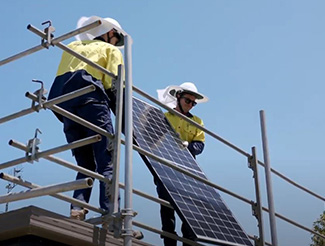Solar panel (rooftop) installation
This page is your go-to hub for safety information on Solar panel (rooftop) installation hazards.
Both solar retailers and installers have safety duties under work health and safety (WHS) laws when installing and maintaining solar panels.
Rooftop solar panels are photovoltaic (PV) systems that generate electricity by absorbing photons from sunlight.
The installation of rooftop solar panels, if done unsafely, can put workers at risk of falls from heights, contact with electricity, exposure to asbestos, being hit by falling objects (e.g. panels) and musculoskeletal injuries.
Who is responsible for safety?
Solar retailers and solar installers have shared WHS duties, including to keep their workers and others (such as the clients, the public and home-owners) safe.
- Solar retailers and installers cannot contract out or transfer their WHS duties.
- The WHS duties in a contractual chain fact sheet explains how contractual relationships fit within the model WHS framework.
Safety musts
Falls from heights are the most common risk in solar installation.
Before starting any rooftop solar panel installation work:
- identify the hazards and risks
- prepare, with consultation from workers, a safe work method statement (SWMS) for each job when:
- the risk of falls is two metres or more
- working on or near electricity or asbestos
- have the correct safety equipment in place before work commences
- use higher order controls, such as roof guard rails, before considering lower order controls, such as fall restraint or arrest (harnesses).
Specific guidance for retailers and installers
Solar retailers
Solar retailers have a responsibility to ensure solar installers have the right capabilities, licences, safety systems and equipment for the job. They must also verify that their solar installers have put safety measures in place.
Retailers can do this by using the tools and resources on this page.
Here are some easy steps retailers can follow:
Step 1: Know your installers
Use the know your solar installers template to collect information on your installers capabilities and equipment, to help you understand what types of jobs you can allocate to them.
As a retailer you should also check your installer has:
- appropriate qualifications and licences
- workers compensation policy
- a safe systems of work and safety equipment
- consulted with workers about safety.
Use this template when onboarding new installers and at regular intervals.
Step 2: Match the right job to the right installer
In order to allocate your installation job to the right installer, use this fall protection assessment template to understand specifics of the job.
When quoting for the job, gather information including:
- roof material and pitch
- height, access and condition of the roof
- are there skylights or fragile roof sheeting.
You can then match the requirements of the job to the installer’s skills and ensure they have the right safety equipment for those specific needs.
The safety controls identified at the time of the site evaluation and that are required to be put into place by the installer, should be clearly detailed in the job specification. The cost estimate for required controls should be included in the job quotation provided to the installer.
Use this template when obtaining information to quote the job.
Step 3: Plan for safety with your installer
Share the fall protection assessment with your installer and use the solar retailers safety checklist as part of your consultation arrangements to:
- discuss the specific risks and agree on control measures
- verify the installer has the appropriate safety equipment (e.g. roof guard rails, panel handling / lifting equipment)
- complete a site-specific safe work method statement (SWMS). Don’t forget to cover off on any falls, electrical and asbestos risks in the SWMS. The SWMS must be tailored to individual sites.
Step 4: Verify your installer is working safely
A retailers’ duties don’t stop with the allocation of a job. Retailers must take steps to verify that their installers are working safely as planned.
You could do this by:
- requesting photographic evidence of safety
- performing random site checks to confirm solar installers have implemented agreed controls.
Solar installers
Solar installers are responsible for planning and implementing control measures to manage risks.
Use the guide to safe solar panel installation and solar installers safety checklist to understand your WHS responsibilities and plan for safety.
Here are some tips:
- use higher order controls, such as roof guard rails, before considering lower order controls, such as fall restraint or arrest (harnesses)
- have a safe work method statement (SWMS) for each job, and follow the safety controls
- ensure equipment is used as per manufacturer's instructions, and by a competent person
- provide safe access and egress to the roof
- ensure electrical work and asbestos removal is completed by a licenced tradesperson
- use a panel lifter to reduce the risk of musculoskeletal disorder (MSD)
- consult workers about each job and provide adequate training and instruction to workers.
Key risks when installing solar
Explore resources for managing other common risks in solar installation:
Tools and resources
General guidance:
For retailers:
- Toolkit: Know your solar installers template (PDF, 670.62 KB)
- Toolkit: Fall protection assessment template (PDF, 132.92 KB)
- Checklist: Solar retailers safety checklist (PDF, 285.92 KB)
For installers
- Checklist: Solar installers safety checklist
- Factsheet: Roof edge protection – temporary systems for working on roofs (PDF, 2885.66 KB)
General safety
- Toolbox talk: Using ladders in construction
- Video: Solar safety – how to manage the risk of falls
- Video: Solar safety – how to manage electrical risks
Codes of practice
- Managing the risk of falls in housing construction (PDF, 2296.79 KB)
- Managing the risk of falls at workplaces (PDF, 2326.56 KB)
- Managing electrical risks in the workplace (PDF, 1337.36 KB)
- Hazardous manual tasks (PDF, 1499.23 KB)
Australian Standards
- AS/NZS3000:2018 Electrical Installations (AUS/NZ Wiring Rules)
- AS/NZS 1170.2011(R2016) Structural Design Actions – Wind Actions
- AS/NZS 4994.1.2009 Temporary edge protection – General requirements
- AS/NZS 4994.1.2009 Temporary edge protection – Roof edge protection – installation and dismantling
- AS/NZS 3760:2010 In-service safety inspection and testing of electrical equipment

